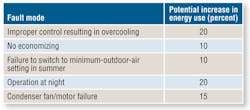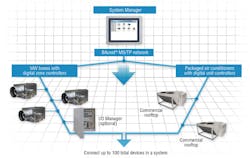Improving the Efficiency of Small to Mid-Sized Buildings
Over the past few decades, great technological advances have been made in HVAC equipment and system design. These advances, such as variable airflow, unitary direct digital controls (DDC), and building energy-management systems, have greatly increased efficiency and comfort while reducing energy and operating costs. Today’s high-performance buildings utilize the latest energy-management strategies for lower utility costs, demand-controlled ventilation (DCV) for improved indoor-air quality (IAQ), and Web-based access for troubleshooting, service, and consistent, reliable comfort.
Unfortunately, these advances have been realized mainly on higher-tonnage equipment serving large facilities. Light-commercial facilities, meanwhile, have remained a largely cost-driven market, with only passing concern for efficiency and life-cycle cost. However, with buildings accounting for nearly 40 percent of carbon-dioxide (CO2) emissions in the United States each year and an aging electrical grid, there has been renewed focus on improving the efficiency of even the smallest facilities.
The latest technological advances have made control and system-integration capabilities available and affordable for small and mid-sized buildings, while providing functionality similar to that of large building automation systems (BAS). By knowing how to take advantage of these systems, a variety of savings can be realized throughout a building’s life.
System Control vs. Thermostat Control
Most commercial buildings utilize packaged HVAC units because of these systems’ simplified design and installation. When installed in a large building, the units typically are controlled with a building-control system. In light-commercial buildings, packaged rooftops and/or heat pumps are controlled almost exclusively with thermostats. This is because thermostats offer the lowest first-cost solution.
Why would one choose system control over thermostat control? One reason is that system controls monitor the status of all of a building’s HVAC components and can alert the right people when there is an issue. Left undiagnosed, small problems can lead to large energy bills or repair costs. In a 2004 New Buildings Institute study,1 91 percent of the packaged rooftop units tested had at least one problem that increased cooling energy consumption by 5 to 40 percent (Table 1). Also, a systems approach to control provides better efficiency and comfort because all system components can work together to provide superior control and efficiency. Thermostat controls are, by nature, decentralized. As a result, scheduling changes and building checks can be a time-consuming process. In today’s world, facility managers are being asked to do more with less so it becomes more important than ever for them to have the right tools to work more efficiently. Smartphones, for example, have created an expectation that most things are remotely accessible via the Web. Why should anything less be expected of a building’s critical HVAC equipment?
Small-Systems Background
Although the latest generation of packaged rooftop units is capable of highly efficient performance, creating high-performance buildings cannot happen solely at a unitary level. A systems approach is the best way to mitigate waste and drive down energy costs. Today’s small packaged HVAC systems with integrated controls can affordably offer most of the control functionality found in larger BAS. Packaged HVAC solutions, unlike larger BAS, do not require on-site engineering or custom programming. When both equipment and controls come from the same manufacturer, all of the components can be programmed at the factory. This offers a near plug-and-play option for fast, easy startup.
Although these first-cost and installation savings can benefit contractors, packaged systems also benefit owners and facilities managers by making their lives easier, their buildings more efficient, and their tenants more comfortable. Intuitive Web-browser-based user interfaces make navigating a system straightforward, while the capability of automatic discovery of new network devices makes them more manageable. Through a touchscreen interface, a user can easily review HVAC operations and building conditions without having to go up onto the roof or open up the ceiling.
Designing high-performance buildings utilizing system-level HVAC control enables the application of energy-saving options, such as:
• Variable air volume (VAV). Constant-volume bypass systems historically have been the system solution of choice for small-building HVAC because of their ability to control at a zone level without the use of variable-frequency drives (VFDs). However, they were not designed for efficiency, as fans always run at top speed, and efficiency plummets as the temperature of the recirculated air entering a unit decreases. For these reasons, Title 24 of the California Code of Regulations proposes a ban on bypass ducts, eliminating the energy credits associated with their zoned performance. With the cost of VFDs decreasing, eliminating the bypass system altogether now is possible and not only increases efficiency, but significantly reduces the cost of ownership. It is estimated that VAV systems use roughly 60 percent of the airflow of their bypass counterparts.
• Scheduling. Proper HVAC equipment scheduling can result in huge energy savings for a building. Equipment controlled by decentralized systems (thermostats) typically are not scheduled optimally. In many cases, they run continuously, resulting in an estimated 20-percent premium of the annual electricity bill. Centralized scheduling, with features such as optimal start and scheduled holidays, reduces run time while eliminating waste.
• Supply-temperature reset. With system-level coordination, advanced control routines can utilize zone-level information to optimize rooftop-unit performance. Supply-temperature-reset strategies allow rooftop units to reduce cooling energy use based on factors such as outside-air temperature, return-air temperature, or worst-case zone. However, supply-temperature reset can cause increased fan and reheat energy on VAV systems, so this should be considered before utilizing this type of control strategy.
• Pressure reset. A pressure-reset strategy adjusts the duct-pressure setpoint on VAV systems based on the worst-case zone. The logic continually drives the duct-pressure setpoint (and fan energy) down until one zone damper opens approximately 100 percent. At this point, the system is providing the minimum amount of cold air to the ductwork needed at any particular moment without starving any of the zones. This optimization technique can yield fan energy savings of roughly 30 to 50 percent over typical fixed-pressure setpoints. The pressure reset also satisfies ANSI/ASHRAE/IES Standard 90.1, Energy Standard for Buildings Except Low-Rise Residential Buildings, and California’s Title 24, which both require this level of building control with DDC at the zone level.
• DCV. In most cases, outside air is much more expensive to condition than recycled building air. Typically, energy savings can be realized by minimizing fresh air, but ventilation requirements can change dramatically. Tracking occupancy changes via occupancy or CO2 sensors and tailoring the amount of fresh air introduced into a building (or a specific zone) ensures good IAQ while minimizing energy use. DCV is especially effective for spaces with high occupancy diversity, such as schools, churches, and courthouses, in which cases it may offer up to 50 percent additional energy savings.
• Demand response/peak shaving. Premium rates resulting from electricity use during peak-demand times can represent a substantial portion of the energy bills of commercial buildings. Also, energy use during this time overburdens the nation’s aging electrical grid, which has given rise to the concept of demand response. Demand response is a request from a utility to reduce a building’s energy use for a period of time. Responding to these requests can save a building owner significant money and provide rebate opportunities. A system-level HVAC approach is far and away the best method of implementing demand-response requests from a power company because thermostats are not equipped to provide this level of control. Also, systems can implement advanced strategies, such as pre-cooling, to reduce the temperature of the thermal mass in a building, thereby reducing the additional cooling required during these afternoon peak times.
• Alarm/fault management. Energy-management systems give customers an early indication of improper operation. This allows them to proactively address issues before a “hot call” is initiated by a tenant. Remote access to critical HVAC components allows facility personnel to change setpoints, clear alarms, or identify improper operating conditions by monitoring trend information. This information access can allow facility personnel to provide temporary relief and ensure maintenance personnel have the right parts and tools for job-site trips, minimizing maintenance costs. Today’s small systems can send e-mail or text messages to support personnel when alarm conditions exist, giving them advanced warning of a potential problem.
Benefits of Packaged Systems
With building controls offering superior efficiency, remote access, and the ability to resolve maintenance headaches, why would anyone construct a building without specifying them? The answer is simple: first-cost concerns. BAS have a reputation for being expensive, complicated, and only necessary for larger facilities or campuses. As discussed, however, small-building systems with integrated controls offer most of the functionality of a BAS at a fraction of the cost.
Additionally, packaged systems are pre-engineered, so they can be implemented with confidence. This eliminates integration hassles, finger pointing, and disputed payments when it is time to turn over a building. When an issue does arise, the system manufacturer can quickly troubleshoot components along with the control logic that governs them.
Finally, packaged systems can be preconfigured at the factory. This means near plug-and-play startup and implementation on the job site by the mechanical contractor. By comparison, custom BAS require days, if not weeks, of on-site programming.
Conclusion
Americans spend 90 percent of their time indoors. They usually spend most of their days going from one building to the next, and most of those buildings are not large, multistory facilities. They are small offices, convenience stores, community centers, and retail buildings. The very same issues that drive the incentive to provide efficient HVAC solutions to larger facilities also exist with smaller buildings. In practice, however, there is less concern when it comes to designing small buildings for efficiency and life-cycle costs (normally the price tag is the driving factor and the lone purchasing decision), a practice that ultimately costs owners and tenants for the life of buildings. Today, highly efficient packaged and pre-engineered systems minimize design and control costs. Existing technology is now affordable to make all buildings high-performance buildings by simply changing our expectations and the approach we take in designing the HVAC in these facilities.
Reference
1) Roth, K., Westphalen, D., Dieckmann, J., Hamilton, S., & Goetzler, W. (2002, July). Energy consumption characteristics of commercial building HVAC systems volume III: Energy savings potential. Table presented at the Buildings Technology Program of the United States Department of Energy.
Chad Senger is a product manager in the controls group of Daikin Applied. He spent his early career as a warranty administrator and technical-response specialist for packaged commercial rooftop units and leverages those experiences to support the development of Daikin Applied’s unitary and building HVAC controls. In his current role, he works with a network of sales representatives, technicians, and engineers to provide prepackaged and customized HVAC control solutions for various light-commercial building applications.




